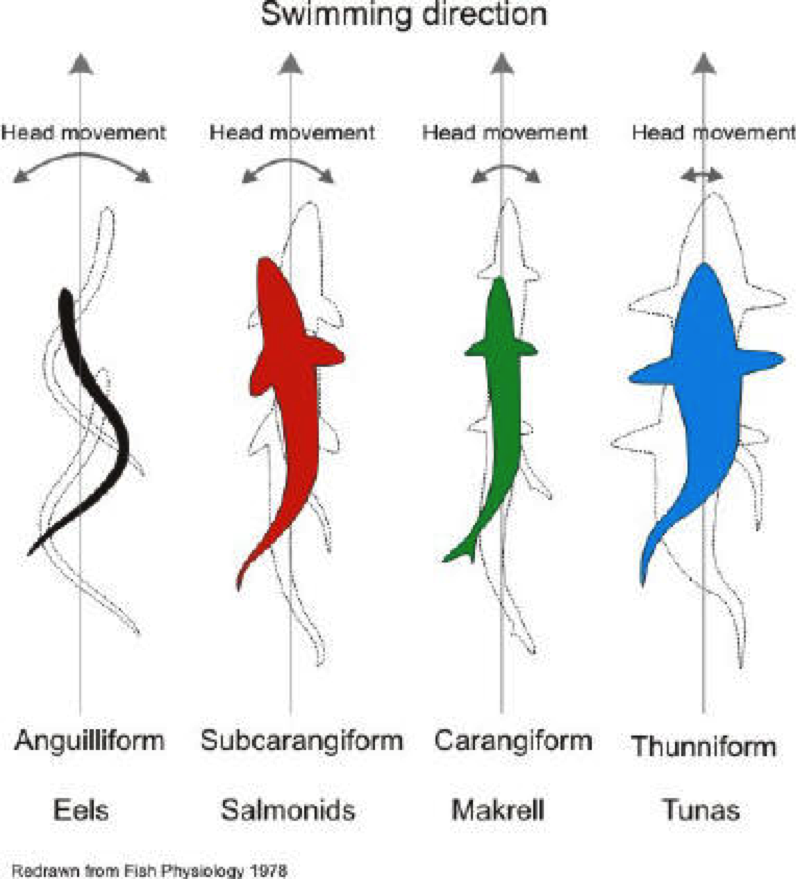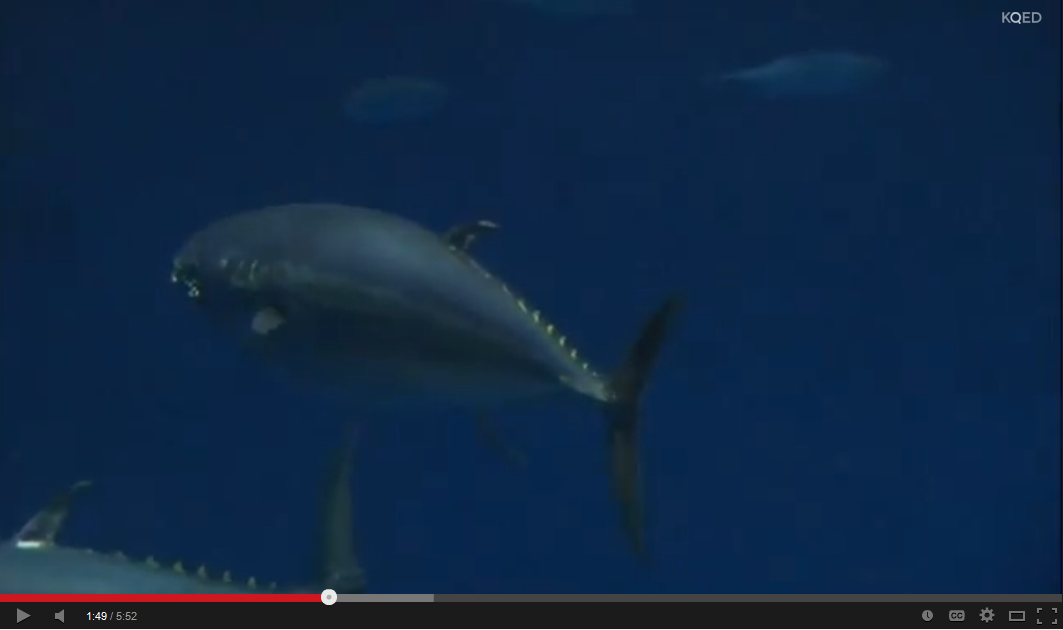Northern Bluefin Tuna
 Scientific Name:Thunnus orientalis
Scientific Name:Thunnus orientalis
Bluefin tuna are some of the fastest fish in the sea. They have streamlined bodies and can even retract their dorsal and pectoral fins to reduce drag in the water. They can swim up to 18 mph for short periods of time. They are the largest of the tuna species, reaching upwards of 680 kg and 3 meters in length. There are three species in each of the Pacific, Atlantic and Southern Oceans. In all oceans bluefins are known for their impressive migrations, routinely crossing ocean basins.
Unique Characteristic: Like all tunas, bluefin are endothermic and can regionally elevate body temperature above ambient water temperature. Comparing results from bluefin with yellowfin and albacore tuna will provide important insights into how endothermy influences movements and habitat selection.
Feeding
- Bluefin tuna is a predator feeding on schools of fish, krill, pelagic red crab, squid.
- Tuna consume as much as 5% of their body weight daily and must continually swim with their mouths open to force water over their gills, supercharging their blood-rich muscles with oxygen.
Breeding and Development
- Pacific bluefin tuna spawn off the coast of Japan, the Philippines and in the Sea of Japan.
- They migrate over 6,000 nautical miles (11,112 km) to the eastern Pacific, eventually returning to their birth waters to spawn.
- In the first few years of life some young tuna make the extensive migration from Japan to the eastern Pacific off California and Mexico.
- They reach maturity around five years of age.
Adaptations
- Tunas are one of the few fishes that are endothermic, which means that they are warm-blooded. But they only maintain warm blood in certain parts of their body, called regional endothermy.
- Regional endothermy is achieved through countercurrent heat exchange, which keeps core organs warm, while allowing the temperature in some peripheral organs to go down.
- The organs they keep warm include the skeletal muscles, eyes, and brain. Maintaining warmer temperatures in these organs enables tunas to maintain higher swimming speed.
- Maintaining warm blood also enables them to travel into a wider range of water temperatures, including water that is really cold (www.nationalgeographic.com).
- Tunas have skinny bodies that are shaped like a torpedo for efficient movement through the water (www.nationalgeographic.com).
- Tunas have tiny fins on their tails, called finlets. Scientists think that these finlets may reduce turbulence in the water as the tuna swims, enabling tunas to move through the water more easily. (www.nationalgeographic.com)
- Tunas have a unique form of body movement while swimming called Thunniform swimming. Thunniform swimming is characterized by minimal head and body movement relative to tail movement. This means that power is concentrated at the oscillating tail, and the body maintains a streamlined position in the water. This is the most efficient swimming mode, and enables tunas to maintain high swimming speeds for long periods of time. This form of swimming is not well suited for slow swimming and rapid turning maneuvers, however (Sfakiotakis et al. 1999).
- Tunas retract their pectoral and dorsal fins to reduce drag while moving through the water (www.nationalgeographic.com)
- Most fishes contain specialized structures for pumping water over their gills to get oxygen. These pumping mechanisms require energy, however. Instead of spending the energy pumping water over their gills, tunas swim with their mouths open. This forces water through their gills, allowing them to put the energy they would have used for gill pumping for swimming instead (Wegner et al. 2012). This process is called ram ventilation.
- Tunas have a large gill surface area to enhance oxygen absorption into the blood (Bernal et al. 2003).
- Tuna blood has a high concentration of oxygen storing molecules, called hemoglobin (Bernal et al. 2003).
- Tunas have large hearts that pump a high volume of blood to muscles designed specifically for sustained swimming. These muscles are called red myotomal muscles. Blood transport systems to these tissues are also highly efficient (Bernal et al. 2003).
- Energy generated by muscles while swimming is conserved to keep the body warm (Bernal et al. 2003).
The video below features an interview with scientist Barbara Block where she explains more about the unique adaptations of the Bluefin tuna.
Conservation
Threats
- Bluefin tuna support one of the most valuable commercial fisheries in the world. Tuna meat is prized in raw fish markets in Asia because it is a popular fish for sushi.
- The demand for tuna meat has led to severe overfishing of Bluefin tuna populations. Estimates are that Atlantic and Southern Bluefin tuna populations have declined by 80-85%.
- Pacific Bluefin tuna are also heavily fished, but population declines are not considered to be as severe for these tunas as they are for tunas in the Atlantic. They are listed on Monterey Bay’s Seafood Watch list as a fish to “avoid.”
- Overfishing of wild tuna populations has led to tuna farming in some regions of the world, including the Mediterranean. Wild tuna are caught as juveniles and raised in tuna farms. This practice has contributed to population declines in regions where farming has occurred.
- The Gulf of Mexico is a major spawning ground for populations of Atlantic Bluefin tuna. The Deepwater Horizon oil spill occurred when tunas migrate into the Gulf of Mexico to breed. There is concern that oil may negatively impact breeding adults, their eggs and sperm, developing larvae, or juveniles.
- Tunas are fished using longlines, which are lines with baited hooks that are set at the surface of the ocean. These lines can range in length from 1 mile to 62 miles. These longlines attract a large number of species, resulting in significant bycatch.
Conservation Measures
- Tuna are wide-ranging species that make frequent migrations across the Atlantic and Pacific. As with sharks, effective conservation of tuna populations requires coordinated action on regional, national, and international levels.
- Several international organizations have been constructed to protect Bluefin tuna populations throughout the world (www.dfo-mpo.gc.ca). These include the International Commission for the Conservation of Atlantic Tunas (ICCAT) in the Atlantic Ocean, and the Inter-American Tropical Tuna Commission (IATTC) and the Western and Central Pacific Fisheries Commission (WCPFC) in the Pacific Ocean.
- These organizations use scientific data to create fishing quotas, or rules about how many tunas can be caught in a particular region. These quotas are based on current estimates of how many individuals are in the population. Regional and international organizations are also responsible for quota enforcement and monitoring fishing activities.
- Monitoring agencies also set rules to reduce unintentional bycatch resulting from tuna longline fisheries.
Tagging and Research
- The successful deployment in recent years of implantable and pop-up satellite archival tags has rapidly enabled researchers to examine the movements of bluefin tunas around the globe.
- These new techniques are advancing our understanding of the distribution of tunas in relation to their dynamic physical and biological environments.
- As more environmental information is gathered from the tagged animals, new insights will be obtained about their individual behaviors, as well as how they respond to environmental variability on daily, seasonal, and inter-annual time scales.
- The tuna are studied using archival tags. These small and powerful tags can last up to 10 years. The tags are surgically implanted in the bellies of the tuna.
- These tags record information on pressure (for depth of dives), ambient light (to estimate location), internal and external body temperature, and, in some cases, speed of travel.
In the following video, watch to see how the tuna are caught and how the tags are implanted into the fish.



